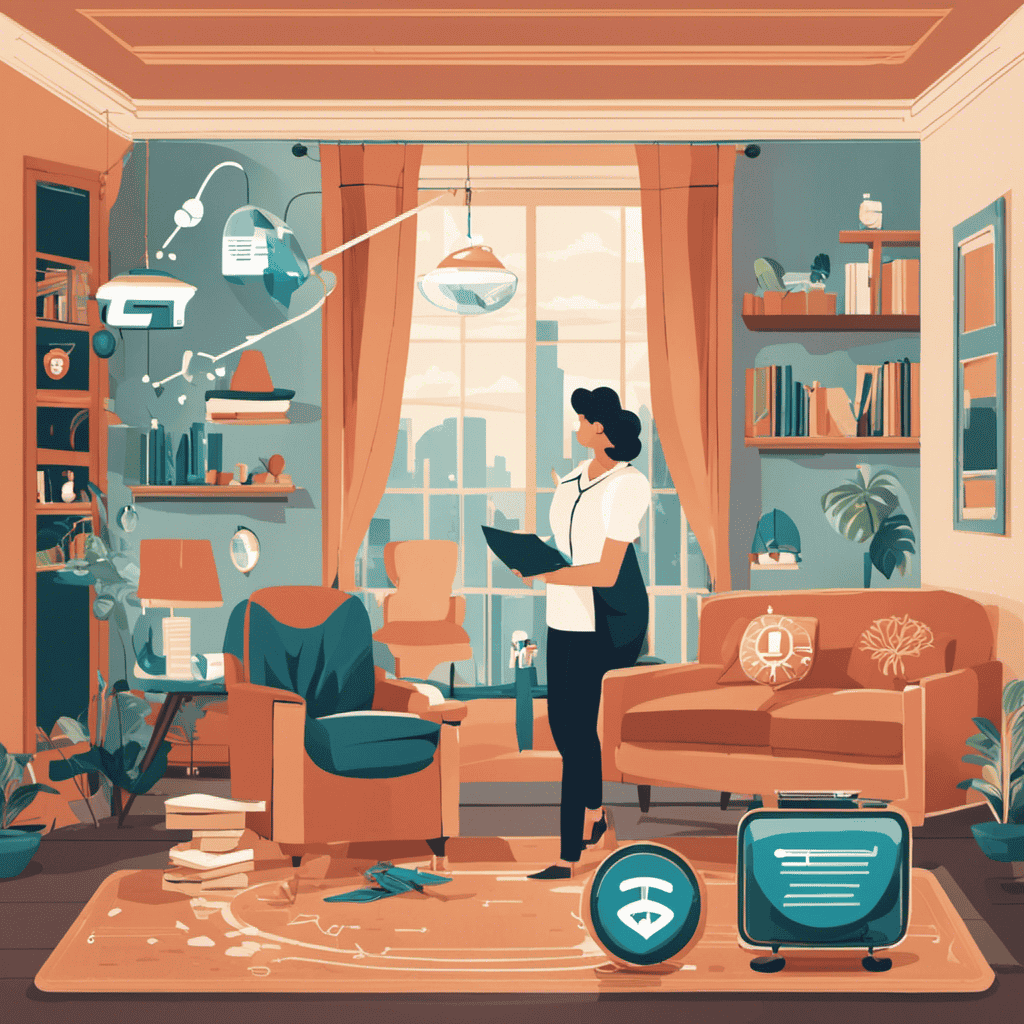As an individual who prioritizes having clean and fresh air in my home, I have frequently pondered if there are alternative methods to purify the air without depending on an air purifier.
It is fascinating to discover that there are actually natural and effective methods to improve indoor air quality. By harnessing the power of houseplants, essential oils, and other do-it-yourself solutions, we can create a clean and dust-free environment without the need for expensive equipment.
In this article, we will explore these strategies and more, providing you with practical tips for purifying the air in your home.
Key Takeaways
- Air purifying herbs and natural air fresheners like basil, thyme, and peppermint can effectively eliminate toxins from the air without the need for an air purifier.
- Houseplants such as Snake Plant, Peace Lily, and Spider Plant have the ability to filter out harmful pollutants and improve indoor air quality.
- Opening windows and doors for proper ventilation allows fresh air to circulate, reducing the concentration of pollutants and improving indoor air quality.
- Essential oils can be used in diffusers, DIY air fresheners, and candles to purify the air naturally and create a clean and refreshing atmosphere in the home, serving as a cost-effective alternative to traditional air purifiers.
Understanding Indoor Air Pollution
Understanding indoor air pollution is crucial in finding effective ways to purify the air without an air purifier.
Indoor air pollution refers to the presence of harmful contaminants in the air inside buildings, such as homes, offices, and schools. These pollutants can come from a variety of sources, including tobacco smoke, cooking and heating appliances, cleaning products, and building materials.
Breathing in these pollutants can have detrimental effects on our health, leading to respiratory problems, allergies, and even more serious conditions such as asthma and lung cancer.
It is important to be aware of these sources of indoor air pollution and their potential health effects so that we can take necessary measures to improve the air quality in our indoor environments.
Identifying Common Air Pollutants
You can easily identify common air pollutants by checking for signs like strong odors or visible particles in the air. Here are three common air pollutants and their health effects:
-
Particulate Matter (PM): These are tiny airborne particles that can be seen as dust, soot, or smoke. They can cause respiratory issues like coughing, wheezing, and shortness of breath. Long-term exposure to PM can lead to lung diseases and even heart problems.
-
Volatile Organic Compounds (VOCs): These are chemicals released from various products like paints, cleaning agents, and building materials. VOCs can cause eye, nose, and throat irritation, headaches, and allergic reactions. Prolonged exposure to high levels of VOCs may lead to liver, kidney, or central nervous system damage.
-
Nitrogen Dioxide (NO2): This is a gas that is produced from burning fossil fuels. High levels of NO2 can irritate the respiratory system, leading to coughing, wheezing, and increased susceptibility to respiratory infections. Long-term exposure to NO2 can exacerbate asthma and other respiratory conditions.
It is important to be aware of these common air pollutants and take necessary measures to minimize their presence in our indoor and outdoor environments in order to protect our health.
Natural Ways to Improve Indoor Air Quality
Using natural methods, we can improve the quality of indoor air. Air purifying herbs and natural air fresheners are effective in reducing pollutants and creating a healthier living environment.
Air purifying herbs like basil, thyme, and peppermint have been scientifically proven to eliminate toxins such as formaldehyde and benzene from the air. These herbs can be placed in pots or dried to create herbal sachets, releasing their cleansing properties into the surrounding air.
Additionally, natural air fresheners made from essential oils, such as lavender or eucalyptus, can provide a pleasant scent while also purifying the air. These natural methods are not only cost-effective but also have the added benefit of being chemical-free, making them a safe and eco-friendly choice for improving indoor air quality.
Transitioning into the subsequent section about using houseplants to purify the air, let’s explore another natural way to cleanse the air in our homes.
Using Houseplants to Purify the Air
As I continue my exploration of natural ways to improve indoor air quality, I am excited to delve into the topic of using houseplants to purify the air.
Houseplants not only add beauty and life to our homes, but they also have the amazing ability to remove harmful pollutants from the air we breathe.
In this discussion, I will be highlighting the best air-purifying houseplants and exploring how they can be effective solutions to indoor air pollution.
Best Air-Purifying Houseplants
One way to improve indoor air quality is by incorporating houseplants that naturally purify the air. Not only do these plants add a touch of greenery to your space, but they also provide numerous air purifying benefits.
Here are three of the best air-purifying houseplants:
-
Snake Plant (Sansevieria): This plant is known for its ability to filter out toxins like formaldehyde and benzene. It releases oxygen at night, making it ideal for bedrooms.
-
Peace Lily (Spathiphyllum): The peace lily is excellent at removing common indoor pollutants, including benzene and ammonia. It also increases humidity, which is beneficial for dry environments.
-
Spider Plant (Chlorophytum comosum): This plant helps to combat carbon monoxide, formaldehyde, and xylene. It’s easy to care for and produces baby spider plants that can be propagated.
To ensure the health and longevity of your air-purifying houseplants, remember to provide adequate light, water, and occasional fertilization. Regularly dusting the leaves and monitoring for pests will also keep your plants thriving and your air clean.
Indoor Air Pollution Solutions?
There are several effective ways to combat indoor air pollution.
Indoor air pollution can have detrimental effects on our health, including respiratory problems, allergies, and even cardiovascular diseases.
One of the simplest and most beneficial ways to combat indoor air pollution is to let fresh air in. Opening windows and doors allows for proper ventilation, which helps to remove pollutants and bring in clean, fresh air.
Fresh air is filled with oxygen and has a lower concentration of pollutants, making it beneficial for our respiratory system. Additionally, fresh air can help in eliminating odors, reducing the risk of mold and mildew growth, and improving overall indoor air quality.
Harnessing the Power of Essential Oils
Using essential oils is an effective way to purify the air without an air purifier. Essential oil diffusers and DIY air fresheners are great tools to harness the power of essential oils and create a clean and refreshing atmosphere in your home.
Here are three ways to use essential oils for air purification:
-
Diffusers: These devices disperse essential oils into the air, allowing their natural properties to purify and cleanse the atmosphere. Simply add a few drops of your favorite essential oil to the diffuser and let it work its magic.
-
DIY Air Fresheners: Create your own air fresheners by combining essential oils with water and using a spray bottle to mist the mixture around your home. This will help eliminate odors and purify the air.
-
Essential Oil Candles: Infuse essential oils into candles to release their purifying properties when burned. Be sure to use natural, non-toxic candles to avoid any harmful chemicals in the air.
DIY Air Purifying Solutions
Now that we understand how essential oils can contribute to air purification, let’s explore some DIY air purifying solutions.
When it comes to improving indoor air quality, there are several effective methods that don’t require an expensive air purifier. One such method is creating homemade air filters. These filters can be made using simple household items like a box fan and a furnace filter. By attaching the filter to the back of the fan, it acts as a barrier, capturing dust, pollen, and other airborne particles.
Additionally, activated charcoal can be used to absorb odors and chemicals from the air. Placing bowls of activated charcoal around the house can help neutralize unpleasant smells.
These DIY solutions are cost-effective alternatives to commercial air purifiers and can significantly improve the air we breathe indoors.
Maintaining a Clean and Dust-Free Environment
To maintain a clean and dust-free environment, you’ll want to regularly dust surfaces, vacuum carpets, and change your bedding frequently. Here are three effective cleaning techniques to help improve air quality in your home:
-
Dusting: Use a microfiber cloth or a damp cloth to trap dust particles instead of spreading them into the air. Start from the top and work your way down, ensuring you reach all surfaces, including shelves, furniture, and electronics.
-
Vacuuming: Invest in a vacuum cleaner with a HEPA filter to effectively remove dust, allergens, and pollutants. Vacuum carpets, rugs, and upholstery regularly, paying extra attention to high-traffic areas.
-
Bedding: Wash your bedding weekly in hot water to eliminate dust mites and allergens. Consider using allergen-proof covers for mattresses and pillows to further reduce exposure.
Other Strategies for Clean Air in Your Home
You can also improve the air quality in your home by regularly cleaning and replacing the filters in your HVAC system. This is an essential strategy for reducing allergens and promoting clean air.
A dirty filter can become clogged with dust, pollen, and other particles, allowing them to circulate throughout your home. By cleaning or replacing the filter every 3 months, you can prevent the buildup of these allergens and ensure that your HVAC system is working efficiently.
Additionally, proper ventilation plays a crucial role in maintaining air quality. Opening windows and doors to let in fresh air can help to dilute indoor pollutants and improve overall air circulation. This can have numerous benefits, including reducing the concentration of allergens, removing stale odors, and promoting a healthier living environment.
Frequently Asked Questions
What Are the Long-Term Health Effects of Indoor Air Pollution?
Long-term exposure to indoor air pollution can lead to various health effects, such as respiratory problems, allergies, asthma, and even cardiovascular diseases. It is important to take measures to purify the air and mitigate these risks.
Can Outdoor Air Pollution Affect Indoor Air Quality?
Outdoor air pollution can greatly impact indoor air quality, like a hidden intruder sneaking into our sanctuary. Harmful pollutants from outside can seep in and affect our health, making it crucial to address and purify the air we breathe indoors.
Are There Any Natural Ways to Reduce Allergens in the Air?
Yes, there are natural remedies to reduce allergens in the air. DIY air filters can be made using materials like activated charcoal or HEPA filters to trap allergens and improve indoor air quality.
How Often Should Houseplants Be Watered to Effectively Purify the Air?
Houseplants should be watered once a week to effectively purify the air. This watering frequency allows plants to thrive and release oxygen while absorbing toxins. One interesting statistic: NASA recommends having one houseplant per 100 square feet for optimal air purification.
Can Essential Oils Be Harmful if Used for Air Purification?
Yes, essential oils can be harmful if used for air purification. They may cause allergic reactions or respiratory issues. There are alternative air purification methods like using houseplants, opening windows, and keeping a clean environment.
Can I Use These Methods to Purify Air Without Air Purifier While Hiding It?
Yes, there are hiding air purifier techniques that can help purify the air without the device being noticeable. Utilizing natural air purifying methods such as houseplants, essential oils, and natural ventilation can significantly improve indoor air quality without drawing attention to the air purifier itself.
Conclusion
In conclusion, you don’t always need an expensive air purifier to purify the air in your home. You can use houseplants and essential oils to harness the power of nature and create a cleaner and fresher environment. Additionally, implementing DIY air purifying solutions and keeping your space clean and dust-free will also contribute to improved indoor air quality. Clean air is like a breath of fresh mountain air, revitalizing and invigorating both body and mind. So, let nature be your guide in purifying the air without the need for a purifier.










